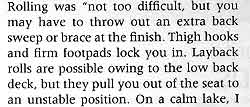
Rapier 20
The reading of the testreport about the Rapier20 in the most recent issue of Seakayaker triggered me to think back to my discussion with Willem Molengraaff, a couple of months ago, as well to rolling sessions with all kind of different seakayaks in the years past by.
The trigger was the following text-passage about rolling the rapier:

Following our discussion, We think of rolling a seakayak as an importanty issue because, when a kayak can be rolled easily, this adds to the safety by a bigger chance of succes under difficult circumstances.
Difficult to understand is: "WHY is a long, slim kayak like the rapier not easy to roll?"
It helps that we had a similar experience with the Godthab from Lettman. This is also a kayak with such characteristics: long, slim and straight. Rolling that kayak made us also wonder already why she was so difficult to roll in spite of her slender appearance.
But, than there is ALSO the Skim Distance: again a long, straight and slender kayak. This kayak rolls much easier than Godthab and Rapier. WHY? Because it has more volume???
Probably it might be concluded that "easy rolling characteristics" are NOT always defined by slim lines.
And also: the design of a kayak can have great influence on the rolling-characteristics of a kayak. Whether is is "easy to roll or not"
Of course the design is not he only parameter responsible for a seakayak to be easily rolled up. First and most important is the ability of the paddler and his or her technique.
There Douglass joined this discussion with his remark about the need for a good solid fit in the boat at the hips and also decent knee braces. Besides that he likes a low backdeck because this helps when you roll by bending backwards.
This is perfectly true and it must be said that once you have good contact with the kayak, almost every kayak can be rolled up.
You can also read my article about [To sit or not to sit](Click this title) about the influence of customising your kayak. (Sorry, this article is still written in Dutch)
BUT: there are differences between kayakdesigns in how easy or how difficult rolling is.
Having rolled quite a lot of seakayaks, our most important conclusion is that it is difficult to find those characteristic design-features of seakayaks which are responsible for "rolling well" or "rolling bad".
Of course there are a few assumptions which can be made on a theoretical base:
- it could be that a kayak with low center of gravity and/or a low volume, will roll easier because the body of the rolling kayaker is longer supported by the water while rolling; thus getting more upward force by the water.
- it could be that a narrower kayak is easier to roll just because it has less rolling resistance.
- It could be that the position of knees is important. It does feel, like when the kayak forces the knees to a higher position and being closer together in the kayak, that rolling is more difficult because such a position of legs and knees locks the hips thus making rolling more difficult.
When trying to find kayaks to fit these parameters we stumble into problems:
For instance :

Explorer with Jos
- the kayak which, to our experience, rolls most easily is the Explorer from NDK. However: this kayak does not seem to have very much rocker, is not low volume and is also not very narrow.
- Then there is the Godthap from Letman and, since now, the Rapier20. These are very narrow and low volume seakayaks. To our experience the Godthab was not easy to roll. Having read the testreport, the Rapier, is not easy to roll either. It is not a lack of knee-braces, because this was excellent in both kayaks. May be there is a point in that this kayak has not much rocker.
- The Mariner from NorthShore can be rolled, but is clearly heavier to roll then the Explorer. There seems some clues here as the Mariner has quite a wide and flat bottom section and also quite a lot of volume amidships, heaving the paddler higher above waterlevel while rolling and thus getting less support from the water in giving upward force to the body.
- Then there are the rolling kayaks as Frey Hofman uses them for inuit-style-rolling: These were easy to roll-kayaks. As they are low-volume, narrow and have some rocker, they seems to fit some assumptions.
These are only a few examples, but to our idea they are not displaying a clear straigth forward explanation for "to roll or not to roll" and we think there are pieces missing in this puzzle.
If you have more ideas about this, you are welcome to join this discussion.
